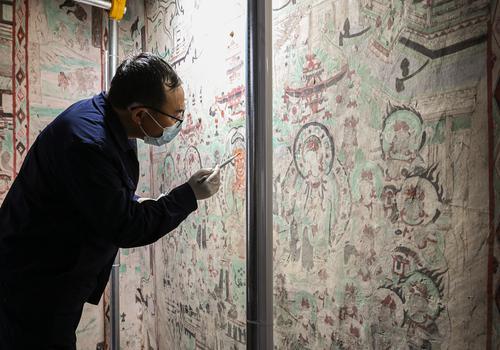 ?
?
Yin Zhihong, a fresco restorer from the Dunhuang Academy, is all concentration as he bends over and painstakingly glues peeling parts of a fresco back into place. He's working in Cave 55 of the Mogao Grottoes in Dunhuang, northwest China's Gansu province, a cave dug in the Song Dynasty, dating back a thousand years. Age and the elements have contributed to the mural layer peeling off, cracking and chipping in the steady march of time.
Yin has become the mural’s "doctor". His movements are very careful, as he inserts a pinpoint-thin bottle nozzle sideways onto the back of fingernail-sized flakes, carefully applies the adhesive, and gently moves it into place with cotton paper and a restoration knife.
Methods to help cultural relics prolong life
The adhesive used by the fresco restorers is a special material, made of a mixture of silicone and acrylic, which is an "artifact" for mural restoration independently developed by the Dunhuang Academy.
"Flaking and efflorescing are the most common diseases in murals," Yin told S&T Daily. Salt efflorescence is a kind of disease produced by the ground layer under the action of water and salt migration, which can cause the ground layer to fall off and is difficult to treat, according to Yin.
"We need to lay cotton paper on the wall to desalinate and replace it regularly, so that salt does not accumulate on the mural, so as to achieve a thorough treatment," said Yin.
It would take at least three years for a team of seven or eight people to complete the restoration of such a cave, according to Yin.
In Dunhuang, there are more than 100 mural restorers like Yin. The existing murals in the Mogao Grottoes are 45,000 square meters. After nearly 80 years of practice, the Dunhuang Academy has formed a complete set of techniques and scientific processes for the protection of murals, and relies on science and technology to prolong the life of the Mogao Grottoes.
Advanced tech brings more possibilities
In 2020, China's first "multi-field coupling laboratory" for cultural heritage protection was officially put into use at the Dunhuang Academy. The laboratory can simulate the temperature of minus 30℃?to 60 ℃, 10-90 percent relative humidity, as well as wind, rain, snow, sun exposure and other climatic conditions throughout the year.
"The simulation environment of ‘multi-field coupling laboratory’ has the advantages of controllable variables, repeatable conditions, accurate data, and the ability to conduct full-scale model tests, etc., in order to preview the changes that China's cultural heritage such as grottoes and soil sites will undergo, which can make the protection measures more accurate, and more scientific and standardized," said Zhang Bo, researcher at the Dunhuang Academy.
Mogao Grottoes get a digital life
The "Digital Dunhuang" project, which was put forward by the Dunhuang Academy in the late 1980s, utilizes digitization technology to preserve the precious materials of Dunhuang murals and painted sculptures permanently and in high fidelity.
Ding Xiaohong works in the Dunhuang Academy and is a member of the team that gives Dunhuang "digital life." He said that in addition to the murals, they will also use laser scanning and three-dimensional reconstruction technology to collect large color sculptures and make the entire cave into three-dimensional digital cultural relics.
"Digitizing caves is tailored to local conditions. Each cave has its own characteristics and collection plan, just like people with different personalities," said Ding.
Dunhuang's experience to the world
While Dunhuang culture is inherently Chinese, the Dunhuang Academy actively shares its expertise with the world. Collaborating with institutions globally, including those in UK, France, India, Afghanistan, Kyrgyzstan and other countries.
"In 2017 or even earlier, we sent different professional investigation teams to India, Afghanistan, Uzbekistan, Kyrgyzstan and other neighboring countries to carry out cultural heritage protection research. These countries are close to us in geography and have [had] frequent cultural exchanges in history. The production techniques and preservation status of many historical relics are very similar to Dunhuang. We were wondering if we can [share] the Dunhuang experience and play a more important role under the framework of the Belt and Road Initiative," Su Bomin, director of the Dunhuang Academy told S&T Daily.
The trio will conduct a series of experiments in fields such as life science, fluid physics, combustion science and materials science. Notably, this is the first time that fruit flies have been taken on a Chinese space mission as experimental subjects. What made scientists choose fruit flies? What experiment will they undergo?
